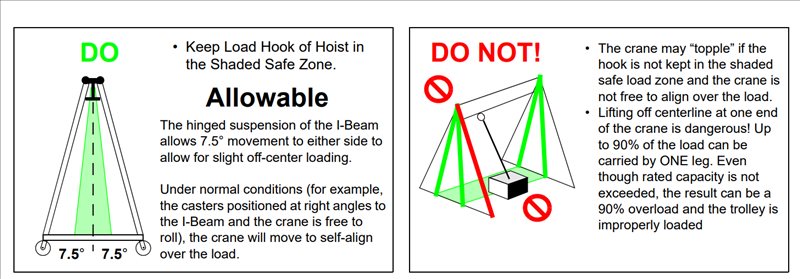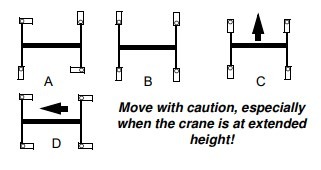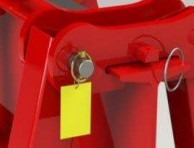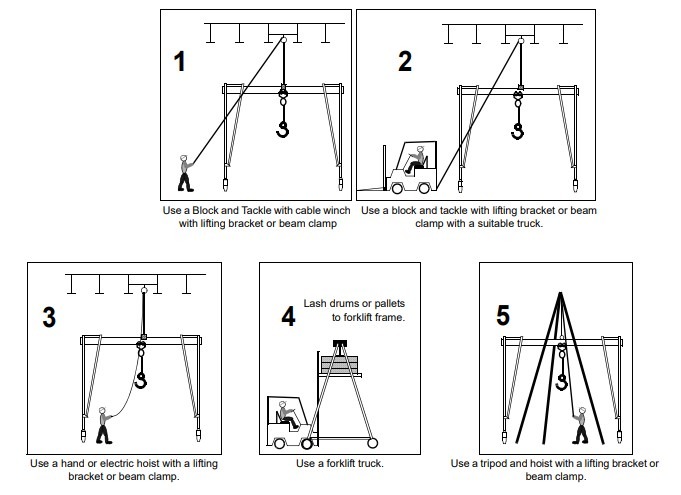Fixed Height Gantry Operating, Adjustment & Inspection Instructions
Read, understand, and comply with all instructions supplied with your crane. Also, pay attention to the equipment used with the crane such as hoists, trolleys, power drives (if applicable). Read, understand, and comply with the requirements of OSHA (Occupational Safety, and Health Administration) 1910.179.
Assembly and Safety Instructions
Inspect Crane Before Moving and/or Each Day’s Use
- Center load under i-beam before lifting.
- When moving the crane under load, position the load at the center of the I-beam.
- DO NOT lift or support humans.
- DO NOT allow the load to swing or roll against any supporting members.
- DO NOT TOW or pull the crane.
- DO NOT OVERLOAD THE CRANE.
- Do not lift loads that are heavier than the rated capacity of the crane.
- Make certain the load is free to be lifted.
Positioning of Crane to Handle Loads

Positioning of Casters

A. To secure crane position while lifting load, lock diagonally opposite casters as shown.
B. To utilize maximum crane strength, lock the casters as shown.
C. To move the crane and/or load it perpendicular to the I-beam, lock casters as shown or allow casters to pivot freely.
D. To move the crane and/or load it parallel to the I-beam, lock casters as shown or allow casters to pivot freely.

Wallace Built-In Safety

Read, understand, and comply with the instructions on the crane and:
A. Rated load clearly stenciled on opposite sides of the I-beam.
B. Rated load clearly stenciled on hoist and trolley
C. Form 379F (this form) is attached in a convenient location by the user.
D. Caution tag attached to locking pins.

CAUTION AREAS
Make certain that all CAUTION labels are in place and legible. Replacements for damaged or missing labels are available upon request.
Inspect that rated capacity is plainly marked on each side of the I-beam. Each hoisting unit shall have its rated load clearly marked and shall be legible from the ground or floor.
Wallace Fixed Height Visual Checkpoints
To ensure the safe operation of your crane, inspect it for bent, broken, worn, corroded, cracked, or missing parts. A series of vital checkpoints are described and shown below. Check these areas closely to ensure that all pins and fastening hardware are in place and securely attached.
Caution Tags are attached to the Locking Rings and Locking Pins in these critical areas to aid in your inspection. DO NOT USE the crane if it does not meet these and the relevant ANSI B30.17 inspection requirements.


1. Brace and main legs are attached to the pin assemblies and secured with locking rings. Locking rings at each end of the I-beam should be in place and secured to ensure the I-beam hardware never slides beyond the end of the I-beam.
2. Lower main legs are attached to the caster frame casting with pins, secured with a Klik pin. Inspect casters and wheels for damage, such as cracks, bent king pins, and freedom of movement. Replace any damaged casters immediately.
General Safety Instructions for Crane Adjustments
- ADJUSTMENTS and/or repairs should be made in an area where they will have the least interference with ongoing operations.
- DO NOT make adjustments when the crane is under load. If the crane is in operation, lower and disconnect the load before making any adjustments.
- SECURE TROLLEY AND HOIST to prevent movement during adjustment of the crane.
Methods of Supporting Crane for Assembly
DO NOT ASSEMBLE, DISASSEMBLE OR MAKE ANY ADJUSTMENTS TO CRANE UNTIL the unit is supported by one of the five methods illustrated below.

NOTE: A PDF version of this document can be printed or downloaded here. PDF also includes the Safe Use and Operation Instructions & Inspection Checklist (Form 504).

